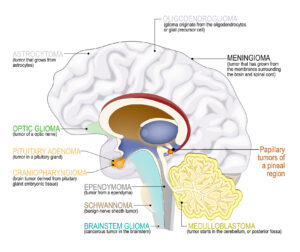There are many unique tumors that can occur within the human body, but this article is going to focus on pediatric brain tumors.
The terminology refers to an abnormal growth inside the skull.
Unfortunately, they’re known to be the most common type of cancer in children. Some can be benign, but regardless of this, both benign and malignant tumors can pose significant health risks.
Early symptoms with brain tumors can develop headaches to varying degrees, alongside many other uncomfortable symptoms.
Symptoms stemming from brain tumors don’t look the same in every child, which can make it challenging to catch early on from a parent’s perspective.
This article will highlight how to catch signs of a possible pediatric brain tumor, the risks, and the associated treatments that are available to children.
The Nuances of Pediatric Brain Tumors
This type of tumor makes up 15% to 20% of all malignancies in children and can cause drastic adverse effects on the body and central nervous system.
For doctors to discern the presentation, signs, and symptoms associated with such tumors, it depends on the tumor’s location, time of diagnosis, and the age of the patient.
Researchers have come up with new molecular-based classifications in addition to targeted therapies for this specific type of tumor.
Over the years, data supports that survival rates continue to increase for those dealing with pediatric brain tumors.
This data is particularly focused on medulloblastoma, and this comes from advancements in surgical techniques and only using radiation therapy if it’s crucial.
The focus of such advancements is to develop better survival rates and reduce neurological complications in the process. Young children’s bodies are much more susceptible to the stress that comes with treating tumors.
Radiation therapies can be extremely damaging, so doctors and surgeons alike are searching for more effective alternatives.
Not only is treatment important, but diving into the prognosis is vital for the future health of the patient as well. Handling a brain tumor of any size in a child requires a careful approach, with the patient’s health and longevity at the forefront of the treatment plan.
The Importance of Prognosis
This term refers to future predictions on the development of the tumor. It also considers the chances of recovery, as tumors are known to be rather resilient.
In many cases, even if the cancer is handled for the time being, there’s a chance it could return in the future.
Factors that play into the prognosis of a pediatric brain tumor include:
- Location
- Grade
- Tumor type
- Growth rate
- Treatment options
- Duration of symptoms
All of these various aspects have to be taken into consideration to develop an accurate and effective prognosis for the child. If any mistakes are made here, it could affect the efficacy of the treatment plan and the longevity of the patient’s health.
Other important factors for the prognosis include the child’s age and the level of impact the tumor has made on the patient’s functional abilities.
As with any cancer, early detection is your best in being proactive on the progressive nature of the tumor.


Different Types of Brain Tumors in Children
Not every type of tumor is bound to be cancerous. It’s important to understand how tumors are classified and what these classifications mean for the health of the patient. With malignant tumors, you’ll find cells that appear extremely different than the image of normal cells.
These types of tumors are the most aggressive and potentially cancerous.
Although the mention of benign tumors is more lighthearted, they shouldn’t be taken lightly. Benign tumors have a similar appearance to normal cells and are known to be of the non-cancerous variety.
Then there’s the non-malignant classification. It holds the same meaning as benign, but it could pose significant health risks that aren’t cancerous.
Even if the word non-malignant is used, parents should promptly seek the treatment their child needs for the pediatric brain tumor.
Understanding the Realities of Treatment
Considering most doctors would rather avoid radiation therapy, this means surgery may be the best course of action for the child.
There are many techniques available to ensure children remain safe in such surgeries. It’s regarded as a much better route than radiation as this can generate numerous health problems in the long term.
Regardless of the tumor’s stage or classification, pediatric brain tumors should be handled as soon as they’re discovered.
Some children suffer more than others, but with early detection, a lot of the pain and stress associated with such tumors can be avoided as best as possible.
It requires collaboration between medical professionals and the parents to achieve the best course of action.
You also want to consider it may require collaboration between numerous medical professionals to develop the most optimal treatment plan for the child in question.
No one will argue that tumors are no joke, but this is especially true for developing bodies such as young children.
Pediatric brain tumors can be hard to discover, so it’s essential to be watchful of the numerous signs mentioned in this article and not overlook their prevalence and how the child is responding to them.
Final Notes
Pediatric brain tumors can be extremely debilitating to life-threatening and potentially minor. It all depends on the factors mentioned in this article.
Equipped with the knowledge in this write-up, parents can ensure they stay on track of their child’s health, even if they can’t see what’s going on inside.
When caught early, tumors can be eliminated with minimal hassle.
If you’re concerned your child is experiencing any of the symptoms mentioned here, it won’t hurt to discuss them with a doctor and explore your options.










